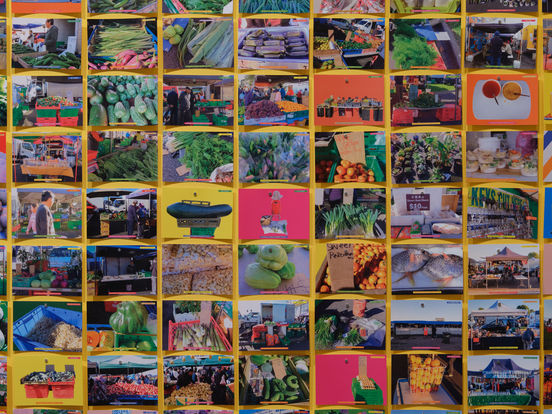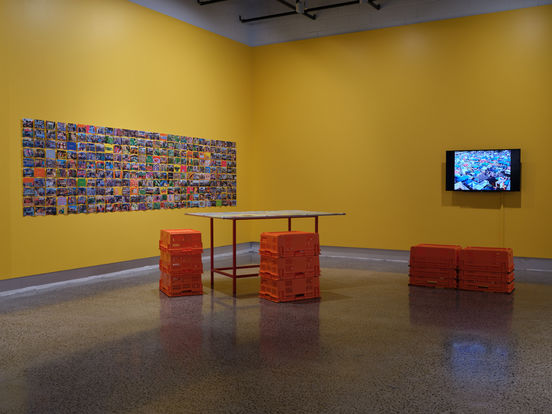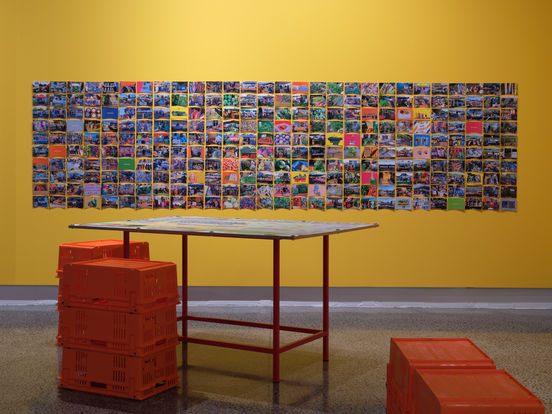Interview with HOOPLA
HOOPLA: HOOPLA is a social enterprise producing urban research, place advocacy, community engagement and design. Established in 2013 by Nina Patel and Kathy Waghorn, HOOPLA works in the Whau area of Tāmaki Makaurau Auckland, where we live.
Objectspace: The exhibition was catalysed by the idea of hostile architecture. This suggests that our experience of the built environment and place can be fraught – in a state of tension that prioritises some people’s needs over others’, and at odds with the natural world. What experiences do you have of hostile architecture in your daily life?
H: HOOPLA is based in Te Whau Avondale. This suburb to the west of the Auckland isthmus is undergoing rapid change. We have experienced this at close hand in relation to the Canal Road native trees. On the corner of Canal Road there was a stand of rare, magnificent native trees –kawaka, mataī, tōtara, tawa, tītoki, pūriri, black maire and others. Planted by Walter Burgess, for almost 100 years Canal Road was an arboretum (where trees are grown for study and display) and a valuable habitat for wildlife. The trees were much loved by locals; most other ‘open space provision’ in the area are sports fields; this was a special patch of mature rākau. In 2012 something known as ‘general tree protection’ was removed from the Resource Management Act. Then last year, Auckland Council halted their process of registering and protecting significant trees in the city. Most people think you are not allowed to cut down mature native trees, but right now across most of Tāmaki Makaurau you can. The owners of the land at Canal Road made a deal to sell to a developer, and as part of that deal they agreed to remove the trees. When they started this work in July 2020 locals physically stepped in, stopping the work, camping in the trees day and night, with a support watch positioned on the kerb. A group, Mana Rākau, was formed and with support from mana whenua an aukatirāhui was put in place. For 245 days this group (that included HOOPLA whānau) kept watch over the trees while working hard to communicate with the developer, council, MPs, Kāinga Ora and other agencies to find solutions that could see housing built in the area while keeping these rākau standing. However, on 9 March 2021 masked contractors, supported by over 100 police, arrived with no warning and felled most of the trees, injuring and endangering the lives of the occupiers and destroying this rare urban ecosystem. This painful event in our neighbourhood is just a microcosm of what is happening across the city, encapsulating the ongoing tension where the ‘rights’ of landowners are prioritised over the values, needs and desires of mana whenua, local residents and wildlife.
OS: Tell us more about your work for Toro Whakaara.
H: Our work explores the Avondale Sunday Market, which takes place close to Canal Road, at the Avondale Racecourse. Since the early 2000s we have been gradually growing our research materials; including making a photographic census of all 250+ stalls, recording time-lapse video, collecting price data, counting visitors at the gates and having conversations with the stallholders, shoppers and the market owner, who manages all the intricacies of the market with such care. With various development plans afoot for the Racecourse land, the future of the market is uncertain. We are interested in the gap between how the market is perceived and what it actually is and does. We want to provide ‘hard evidence’ on how it functions as an economy, and to discover what the reach of this economy is – socially (including well-being measures such as social contact and access to culturally valued food), environmentally (reducing food waste and packaging, fostering the re-use of second-hand goods) and economically (income generation, multi-generational employment, food security). In a time when the supermarket duopoly is being investigated for its tight hold on the food systems of Aotearoa, markets such as Avondale’s should be studied for the ways they provide alternative systems.
OS: How do your practices as urban and architectural practitioners frame your understanding of the site and influence this work?
H: We see the work of HOOPLA as critical of a normative understanding of architecture, one that is concerned with buildings as objects. Instead we align our work with the idea of ‘critical spatial practice’ put forward by Jane Rendell who recognises that ‘architecture [...] continue[s] to be challenged by the idea that aesthetic values might not only be object-driven but also related to time, process, ethics and subjectivity’.¹ We hope that our work expands architecture by recognising and working with places as they are composed through connection to larger cultural, social and economic forces. Unlike typical architectural ways of working that are constrained by the idea of a singular and bounded ‘site’, we are more interested in working with ideas of place, following the geographer Doreen Massey, where place is ‘imagined as articulated moments in networks of social relations and understandings’.² Expanding architecture into forms of urban research means finding and inventing ways to document the networks that Massey describes (and recognising that sometimes these networks resist documentation for good reasons!). Our ‘network’ approach is beginning to be valued – we are happy to be collaborating with architects who know a building’s success will be as part of a neighbourhood network, understanding the neighbourhood as a place and not just as a ‘site’.
OS: The exhibition captures fragments of the built environment and land use that often go unseen – perhaps because they are so much a part of our everyday experiences. What would you like the viewer to be seeing in your work?
H: We are interested in documenting the market in order to provide evidence and advocate for its importance as an economy. Through the research work that we have been carrying out we are attempting to document the complexity and density of time, space and exchange through the use of certain drawing, video and photography techniques. We have used abstract forms of mapping to notate information and data that is spatial, social, material and temporal – misshapen fruit, products with packaging mistakes, re-used goods, spare parts, sellers, buyers, bananas, buns, buskers, miracles – we are attempting to get these all on the same page. We want to capture and communicate the persistence of the market as a less regulated space, an economy that operates tactically, offering a critically important alternative to mainstream consumerist spaces.
1. Rendell, J. (2013) A Way with Words: Feminists Writing Architectural Design Research. In M Fraser (ed.), Design Research in Architecture: An Overview (pp.117-136). Ashgate.
2. Massey, D. (1991). A Global Sense of Place. Marxism Today, 24–29.
—
This text is republished from Toro Whakaara: Responses to our built environment, a publication produced by Objectspace to accompany an exhibition of the same name. The publication is edited by Tessa Forde, and copy-edited by Anna Hodge.

(above & below) Details of HOOPLA's installation Avondale Sunday Markets in Toro Whakaara: Responses to our built environment. Photograph by Samuel Hartnett.

